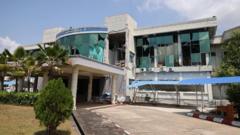Myanmar's military ruler, Senior General Min Aung Hlaing, revealed in a government meeting that the recent earthquake, which struck on March 28, severely impacted the capital city, with approximately 70% of its government buildings suffering damage due to their foundations on unstable soil. As a part of the reconstruction efforts, the city will see a reconfiguration of its infrastructure, focusing on the use of materials and designs that enhance seismic resilience.
The earthquake, measuring 7.7 on the Richter scale, resulted in a tragic loss of life, with state reports indicating over 3,500 casualties and thousands of injuries. It also had far-reaching effects, with tremors felt across neighboring countries like Thailand and China. The military council has already begun damage assessment; images released show significant destruction to key government buildings, including several ministries.
Interestingly, since their relocation to Nay Pyi Taw in 2005, the former military junta had never fully explained the rationale behind moving the capital 370km inland from the bustling city of Yangon. Nay Pyi Taw, characterized by sprawling layouts and grandiose structures, now faces an uncertain future as reconstruction could span several years.
In response to the immediate needs caused by the disaster, several ministries, including Foreign Affairs and Tourism, have temporarily moved operations back to Yangon. Other government departments are navigating the aftermath by relocating to temporary structures, constructed with steel frames, known as "hotai."
Efforts are underway by cultural institutions, such as the National Museum, to preserve invaluable historical artifacts, manuscripts, and literature threatened by the catastrophe. While a 20-day ceasefire has been declared to facilitate humanitarian efforts, reports suggest that military engagements continue in conflict zones across the country, complicating relief operations.
Myanmar remains at a crossroads as it confronts the dual challenges of rebuilding its capital while managing ongoing civil unrest resulting from a military coup initiated in 2021. The path ahead requires both strategic planning for sustainable urban reconstruction and concerted efforts to restore peace in deeply divided regions.
The earthquake, measuring 7.7 on the Richter scale, resulted in a tragic loss of life, with state reports indicating over 3,500 casualties and thousands of injuries. It also had far-reaching effects, with tremors felt across neighboring countries like Thailand and China. The military council has already begun damage assessment; images released show significant destruction to key government buildings, including several ministries.
Interestingly, since their relocation to Nay Pyi Taw in 2005, the former military junta had never fully explained the rationale behind moving the capital 370km inland from the bustling city of Yangon. Nay Pyi Taw, characterized by sprawling layouts and grandiose structures, now faces an uncertain future as reconstruction could span several years.
In response to the immediate needs caused by the disaster, several ministries, including Foreign Affairs and Tourism, have temporarily moved operations back to Yangon. Other government departments are navigating the aftermath by relocating to temporary structures, constructed with steel frames, known as "hotai."
Efforts are underway by cultural institutions, such as the National Museum, to preserve invaluable historical artifacts, manuscripts, and literature threatened by the catastrophe. While a 20-day ceasefire has been declared to facilitate humanitarian efforts, reports suggest that military engagements continue in conflict zones across the country, complicating relief operations.
Myanmar remains at a crossroads as it confronts the dual challenges of rebuilding its capital while managing ongoing civil unrest resulting from a military coup initiated in 2021. The path ahead requires both strategic planning for sustainable urban reconstruction and concerted efforts to restore peace in deeply divided regions.

















